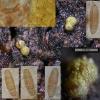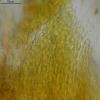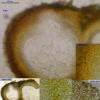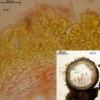
14-01-2009 07:19
VASILEIOS KAOUNASIT WAS FOUND IN RAFINA GREECE, 13-01-09, HYPOGEUS

13-01-2009 00:29
 Yannick Mourgues
Yannick Mourgues
Bon, après je vous laisse (presque) tranquille, c

11-01-2009 23:52
 Yannick Mourgues
Yannick Mourgues
Bonsoir. Avec Nectria lamyi, Il y avait aussi u

11-01-2009 20:36
 Illescas Tomás
Illescas Tomás
Buenas tardes de nuevo: En compañía de la Che
Bionectriaceae
Hans-Otto Baral,
19-01-2011 22:34
 Hi all
Hi allHere I have a Bionectriaceae as I believe. Before I get lost in the literature I am sure some of you can give me an idea much faster.
It grew on bark together with Rhytidhysteron, Orbilia corculispora and other Orbilias, on a xeric branch of Gejera parviflora in S of Rockhampton in Queensland, Australia, 1998 :-)
I did not care for it over 10 years ago, but was now surprized by its striking yellow colour when accidentally looking into the material.
Spores (dead) 17.5 - 23.5 x 6-6.7 µm, 6-11-celled, with striking longitudinal ridges.
Zotto
Christian Lechat,
20-01-2011 04:57

Re:Bionectriaceae
Hi Zotto,
did you test the reaction of ascomata in KOH or lactic acid? what is the thickness of ascomatal wall?
Please, send us a photo of lateral ascomatal wall in vertical section.
Christian
did you test the reaction of ascomata in KOH or lactic acid? what is the thickness of ascomatal wall?
Please, send us a photo of lateral ascomatal wall in vertical section.
Christian
Hans-Otto Baral,
20-01-2011 08:36

Re:Bionectriaceae
Hi Christian
before going to bed I tested KOH :-) It is totally negative. I will do a section today and also test lactic acid.
Zotto
before going to bed I tested KOH :-) It is totally negative. I will do a section today and also test lactic acid.
Zotto
Hans-Otto Baral,
20-01-2011 17:36

Re:Bionectriaceae
I tested again KOH: not the least change in intensity of the yellow peridial wall. Here is a section (in KOH), a bit thick, but surely 80 µm thick.
In this perithecium which looked identical with the previous one and only a few mm away, I saw only smooth hyaline spores 16-21 x 5-5.5 µm, wit 1-5 septa, and not so many as yesterday, also they were inside the asci now. I strongly assume these are immature spores.
Zotto
In this perithecium which looked identical with the previous one and only a few mm away, I saw only smooth hyaline spores 16-21 x 5-5.5 µm, wit 1-5 septa, and not so many as yesterday, also they were inside the asci now. I strongly assume these are immature spores.
Zotto
Christian Lechat,
20-01-2011 18:16

Re:Bionectriaceae
Ok Zotto,
we have to know if the ascomata change color in lactic acid, that is very important because some Nectriaceae not changing color in KOH become bright yellow in lactic acid.
Moreover, could you confirm that there are warts on the ascomatal surface as I see on your plate?
Christian
we have to know if the ascomata change color in lactic acid, that is very important because some Nectriaceae not changing color in KOH become bright yellow in lactic acid.
Moreover, could you confirm that there are warts on the ascomatal surface as I see on your plate?
Christian
Hans-Otto Baral,
20-01-2011 21:45
Martin Bemmann,
20-01-2011 21:51

Re:Bionectriaceae
Hello Christian,
do you see warts, verrucose spores? I see them as smooth but striate.
Regards,
Martin
do you see warts, verrucose spores? I see them as smooth but striate.
Regards,
Martin
Hans-Otto Baral,
20-01-2011 22:09

Re:Bionectriaceae
About the warts: Christian means the perithecia, not the spores :-)
I searched for them, no, there are no warts really, only somewhat liberating thik-walled surface cells, and some kind of rough-granular exudate on the outside, which might carry the yellow pigment.
Zotto
I searched for them, no, there are no warts really, only somewhat liberating thik-walled surface cells, and some kind of rough-granular exudate on the outside, which might carry the yellow pigment.
Zotto
Martin Bemmann,
20-01-2011 22:15

Re:Bionectriaceae
"About the warts": I shoud read twice.... :-/
Martin
Martin
Christian Lechat,
21-01-2011 08:05

Re:Bionectriaceae
Hi Zotto,
I received your images, thank you.
I think your collection is too old, it's maybe why there is no reaction in KOH or lactic acid.
In my opinion, it would be rather a Nectriaceae but, unfortunately, we don't know its anamorph and it is maybe too old to be cultivated, the ascospores being dead as you say. The only thing which I'm sure, it's that I never saw this species previously and I don't know what it is. Did you try a culture?
Christian
I received your images, thank you.
I think your collection is too old, it's maybe why there is no reaction in KOH or lactic acid.
In my opinion, it would be rather a Nectriaceae but, unfortunately, we don't know its anamorph and it is maybe too old to be cultivated, the ascospores being dead as you say. The only thing which I'm sure, it's that I never saw this species previously and I don't know what it is. Did you try a culture?
Christian
Hans-Otto Baral,
21-01-2011 09:22

Re:Bionectriaceae
This is strange, that the reaction should fade within 12 years. What about old type material, is it impossible there to recognize even the family?
The spores are 100% dead, I am very sure. Therefore we can forget a culture. I always cannot remember to have seen this species elsewhere.
But is there no known Hypocreales with these spore characters, striate and multiseptate? I remember I saw only 1-septate with striate spores in the literature.
Zotto
The spores are 100% dead, I am very sure. Therefore we can forget a culture. I always cannot remember to have seen this species elsewhere.
But is there no known Hypocreales with these spore characters, striate and multiseptate? I remember I saw only 1-septate with striate spores in the literature.
Zotto
Hans-Otto Baral,
23-01-2011 16:12

Re:Bionectriaceae
I looked again at the specimen because Martin doubted a bit whether the spores are really multiseptate. They are, but there is a central primary septum which has small lateral thickenings which the other septa do not have. In broken spores the secondary septa are clearly seen in Congo Red. Again I found up to 10 septa.
I could not stain the ridges in CR nor in CB.
I could not stain the ridges in CR nor in CB.
Christian Lechat,
23-01-2011 17:30

Re:Bionectriaceae
Hi, Zotto,
It would seem that it's a Nectriaceae as I thought it.
It would seem that it's a Nectriaceae as I thought it.
Hans-Otto Baral,
23-01-2011 17:51

Re:Bionectriaceae
O.k.
Martin drew my attention to Albonectria in Rossman et al. 1999, a Nectriacee in which KOH does not give a reaction. But the spores there are too big and the septa to few.
Is there no possibility to stain the ridges of the spores?
Zotto
Martin drew my attention to Albonectria in Rossman et al. 1999, a Nectriacee in which KOH does not give a reaction. But the spores there are too big and the septa to few.
Is there no possibility to stain the ridges of the spores?
Zotto
Christian Lechat,
23-01-2011 18:12

Re:Bionectriaceae
Albonectria is very different, you can see it here: http://www.ascofrance.fr/index.php?r=bdd&page=fiche&id=11
Regards,
Christian
Regards,
Christian
Hans-Otto Baral,
23-01-2011 18:56

Re:Bionectriaceae
So this genus was moved to the Bionectriaceae after Rossman 1999?
What about staining ridges, you sent me photos of striate spores of Hydropisphaeria bambusicola, the ridges stained blue in CB. Why did these ones not stain? Must I use a higher concentration?
Zotto
What about staining ridges, you sent me photos of striate spores of Hydropisphaeria bambusicola, the ridges stained blue in CB. Why did these ones not stain? Must I use a higher concentration?
Zotto







